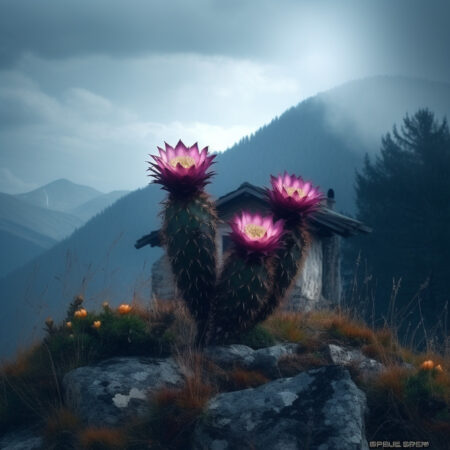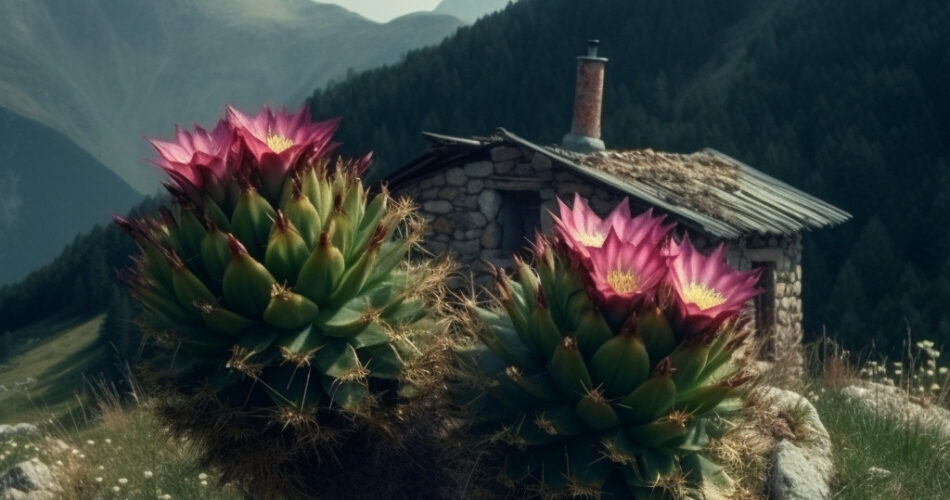Key Takeaways:
- The Lobivia cacti belong to the Echinopsis genus and are native to South America.
- This cacti have vibrant and colorful flowers and can adapt to various environments.
- European explorers brought this cactus to Europe, leading to their popularity worldwide.
- Rare and striking varieties of Lobivia include Lobivia pentlandii, Lobivia famatimensis, Lobivia arachnacantha, Lobivia ferox, and Lobivia valdeziana.
- Growing it requires bright light, well-draining soil, proper watering, and fertilizing.
- Caring for this cacti involves protecting them from pests and diseases, pruning, and propagation.
- During winter, it enters dormancy and require specific care for overwintering.
- Creative display ideas for this cacti include indoor arrangements, desert-themed landscapes, and photography.
1. The Fascinating World of Lobivia Cacti
The world of Lobivia cacti is both captivating and diverse. These unique cacti belong to the Echinopsis genus and are native to South America, particularly the Andes Mountains. Known for their striking beauty and remarkable ability to adapt to various environments, Lobivia cacti have become a favorite among collectors and gardening enthusiasts.
1.1 An Introduction to Lobivia Cacti
Lobivia cacti, are characterized by their vibrant and colorful flowers that bloom from the apex of their cylindrical stems. These flowers can range in color from red, orange, yellow, pink, and even white. Lobivia cacti are small to medium-sized, usually growing no more than a foot tall.
One of the most fascinating aspects of it is their ability to withstand extreme temperatures. They can survive in high altitudes at sub-zero temperatures, as well as thrive in warmer climates. This hardiness makes them excellent options for both indoor and outdoor cultivation.
1.2 The History and Origin
The history of Lobivia cactus dates back several centuries. These cacti were initially discovered and cultivated by indigenous communities in the Andean region of South America. They were highly revered for their medicinal properties and were used for treating various ailments.
During the 18th and 19th centuries, European explorers and botanists became enamored with the beauty of it and began bringing them back to Europe. The cacti’s popularity grew, and soon they found their way into botanical gardens and private collections around the world.
1.3 The Rarest and Most Striking Varieties
There are numerous varieties of this cacti, each with its unique characteristics and charm. Here are some of the rarest and most striking varieties that every cactus enthusiast should know about:
1. Lobivia pentlandii: This variety is known for its distinct red flowers and elongated stems. It is native to the higher altitudes of the Andean region.
2. Lobivia famatimensis: With its vibrant orange blooms and compact size, this variety is a true standout. It originates from the Famatina Valley in Argentina.
3. Lobivia arachnacantha: This unique variety is characterized by its spidery spines and pink or purple flowers. It is native to the high altitude regions of Bolivia.
4. Lobivia ferox: Known for its dense clusters of golden spines and bright yellow flowers, this variety adds a touch of exotic beauty to any collection.
5. Lobivia valdeziana: With its striking magenta flowers, this variety is a true showstopper. It is found in the mountainous regions of northwestern Argentina.
These are just a few examples of the many incredible Lobivia cacti varieties that exist. Each variety offers a unique and awe-inspiring display of colors and forms, making them a prized possession for collectors.
2. Growing Lobivia Cacti: A Step-by-Step Guide
Growing this cactus can be a rewarding and fulfilling experience for plant enthusiasts. While these cacti are known for their resilience, proper care and attention are essential to ensure healthy growth and stunning blooms. Here is a step-by-step guide to help you successfully cultivate Lobivia cacti:
2.1 Choosing the Ideal Location
Lobivia cacti thrive in bright light and require at least six hours of direct sunlight each day. When choosing a location for your cacti, look for a spot near a south-facing window or an area in your garden that receives ample sunlight. If you live in an area with hot summers, providing some afternoon shade can help protect the cacti from extreme heat.
It’s important to note that these are also capable of thriving under artificial lighting. If you don’t have access to sufficient natural light, consider using fluorescent or LED grow lights to supplement their light requirements.
2.2 Finding the Perfect Soil and Pot
This cacti require well-draining soil to prevent waterlogged roots and potential rotting. A mix of equal parts potting soil, perlite, and coarse sand works well for growing. This combination ensures proper drainage while still retaining sufficient moisture for their needs.
When selecting a pot for your cactus, opt for one with drainage holes at the bottom to allow excess water to escape. Terra cotta pots are an excellent choice as they are porous and help wick away excess moisture.
2.3 Watering and Fertilizing Techniques for Healthy Cacti Growth
Proper watering is crucial for the health and growth of Lobivia cacti. These cacti are adapted to survive in arid environments, so it’s important not to overwater them. Allow the soil to dry out between watering sessions and only water when the top inch of soil feels dry to the touch.
During the spring and summer months, when cacti are actively growing, you can increase the frequency of watering. However, during the dormant period in fall and winter, reduce watering to prevent rotting.
When it comes to fertilizing, a balanced cactus fertilizer diluted to half strength is ideal. Apply the fertilizer every two weeks during the growing season but refrain from fertilizing during the dormant period.

3. Caring for Lobivia Cacti: Tips and Tricks
In addition to proper growth conditions, Lobivia cacti require specific care and attention to ensure their health and vitality. Here are some tips and tricks for caring for your Lobivia cacti:
3.1 Protecting It from Pests and Diseases
Like all plants, it can be susceptible to pests and diseases. Common pests that may affect these cacti include mealybugs, scale insects, and spider mites. Regularly inspect your cacti for any signs of infestation, such as tiny webs, sticky residue, or discoloration on the stems. If pests are present, treat them with appropriate organic or chemical insecticides.
Preventing fungal diseases is essential for maintaining the health of your cacti. Avoid overwatering and provide adequate air circulation to prevent the growth of fungi. If you notice any signs of rot or fungal infection, promptly remove the affected areas and adjust your watering routine.
3.2 Pruning and Propagating
Pruning Lobivia can help maintain their shape and promote healthy growth. Use clean pruning shears to carefully remove any dead or diseased parts of the plant. Additionally, you can trim back any elongated branches to encourage a more compact and aesthetically pleasing form.
Propagation is another exciting aspect of caring. These cacti can be propagated through various methods, including seed germination, offsets, and stem cuttings. Each method requires specific techniques and conditions, and mastering these propagation methods can greatly expand your collection of Lobivia.
3.3 Overwintering: Preparing for Cold Weather
During the winter months, Lobivia enters a period of dormancy. It’s crucial to prepare them for the cold weather to ensure their survival and continued health. Here are some steps to follow for successful overwintering:
- Gradually reduce watering in the fall to allow the cacti to enter their dormancy period.
- Move the cacti to a location with cooler temperatures, ideally between 50-55°F (10-13°C).
- Limit exposure to direct sunlight during the winter months to prevent sunburn on the dormant cacti.
- Resume regular watering in the spring as the cacti come out of dormancy.
4. Showcasing the Beauty of Lobivia: Creative Display Ideas
There are endless possibilities when it comes to showcasing the beauty of this amazing cactus. Whether displayed indoors or incorporated into a desert-themed landscape, these cacti can add a touch of natural elegance to any setting. Here are some creative ideas for displaying Lobivia cacti:
4.1 Creating Stunning Arrangements for Indoor Settings
Lobivia cacti can be the centerpiece of a beautiful indoor arrangement. Combine various Lobivia varieties with contrasting shapes and colors to create visually appealing displays in planters or terrariums. Pair them with other succulent plants or decorative rocks to add depth and texture to the arrangement.
4.2 Designing a Desert Oasis: Landscaping
A desert-themed landscape can create a unique and striking outdoor display. Incorporate Lobivia cacti into rock gardens or xeriscapes, mimicking their natural habitat. Group them together in clusters of various heights and sizes to create a visually dynamic and captivating desert oasis.
4.3 Photographing: Capturing the Essence of their Marvels
Photographing Lobivia cacti allows you to capture their intricate details and vibrant colors. Experiment with different angles, lighting conditions, and backgrounds to showcase the cacti’s beauty. Macro photography can reveal the intricate patterns of their spines and the delicate structure of their flowers.
Remember to respect the cacti and their surroundings when photographing. Avoid any actions that may harm the plants or their natural habitat.
The world of Lobivia cacti is a captivating one. Their stunning beauty, resilience, and ability to thrive in various conditions make them a captivating addition to any plant collection. By following the expert guidelines provided in this comprehensive guide, you can successfully cultivate and care for Lobivia cacti, creating an enchanting display of nature’s marvels.
FAQ
Question: Are Lobivia cacti suitable for indoor and outdoor cultivation?
Yes, It can adapt to different environments and are suitable for both indoor and outdoor cultivation. They require bright light and can withstand extreme temperatures.
Question: How do I choose the ideal location for my Lobivia cacti?
This cacti thrive in bright light and require at least six hours of direct sunlight each day. Choose a spot near a south-facing window or in your garden that receives ample sunlight. If you live in a hot climate, provide some afternoon shade to protect them from extreme heat.
Question: What type of soil and pot should I use for Lobivia cacti?
Use well-draining soil for your cacti to prevent waterlogged roots. A mix of equal parts potting soil, perlite, and coarse sand works well. Choose a pot with drainage holes at the bottom, preferably made of porous material like terra cotta, to allow excess water to escape.
Question: How often should I water and fertilize my Lobivia cacti?
Water it when the top inch of soil feels dry to the touch. Allow the soil to dry out between watering sessions. In the spring and summer, when they are actively growing, you can increase the frequency of watering. Fertilize with a balanced cactus fertilizer diluted to half strength every two weeks during the growing season, but refrain from fertilizing during the dormant period in fall and winter.
Question: How do I protect Lobivia cacti from pests and diseases?
Regularly inspect your cacti for signs of pests such as mealybugs, scale insects, or spider mites. Treat infestations with appropriate insecticides. Prevent fungal diseases by avoiding overwatering and providing adequate air circulation. If you notice any signs of rot or fungal infection, promptly remove the affected areas and adjust your watering routine.
Question: Can I propagate Lobivia cacti?
Yes, it can be propagated through seed germination, offsets, and stem cuttings. Each method requires specific techniques and conditions. Propagation can expand your collection of Lobivia cacti.
Question: How do I overwinter Lobivia cacti?
Gradually reduce watering in the fall to allow the cacti to enter dormancy. Move them to a location with cooler temperatures, ideally between 50-55°F (10-13°C). Limit exposure to direct sunlight during the winter months. Resume regular watering in the spring as the cacti come out of dormancy.
Question: What are some creative display ideas for Lobivia cacti?
It can be displayed indoors in arrangements with other succulent plants or decorative rocks. They can also be incorporated into desert-themed landscapes by grouping them together in rock gardens or xeriscapes. Photography is another way to capture the beauty of Lobivia cacti, experimenting with different angles, lighting conditions, and backgrounds.




Comments